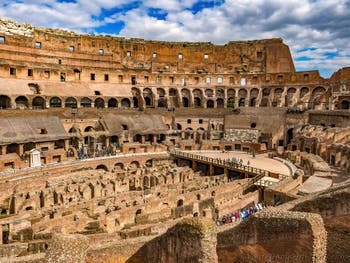Colosseum Games Martyrs | Location | Opening Hours Tickets | Authorisations | Roman Forum
Games Martyrs Story Architecture | Games Gladiators | Martyrs
The Colosseum in Rome, Christian Martyrs and Death Sentenced
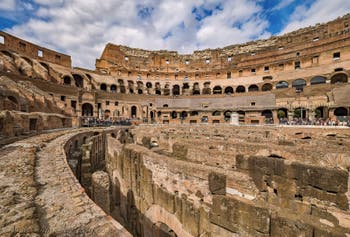
Colosseum Arena in Rome Films and TV series feature Christians condemned to death and executed in the worst conditions, devoured by wild animals in the arena of the Colosseum.
A false truth still widespread in the previous centuries.
Indeed, there is no document, no archaeological element that can prove that only one Christian was executed in the Colosseum.
There have been executions of Christian martyrs in Rome, the most famous of which were those carried out by Nero who accused them of burning Rome.
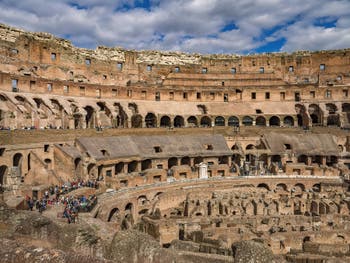
Colosseum Arena in Rome The executions of Christians in Rome were in fact exceptional, and made at specific times, even Nero never drafted any law concerning Christians.
Many of these executions took place in Circus Maximus, but none in the Colosseum.
Just listen to Charles Dickens to see that this false truth was still believed in 1877:
« Some accounts make these the prisons of the wild beasts destined for the amphitheatre; some, the prisons of the condemned gladiators; some, both.
But the legend most appalling to the fancy is, that in the upper range (for there are two stories of these caves) the Early Christians destined to be eaten at the Coliseum Shows heard the wild beasts, hungry for them, roaring down below; until, upon the night and solitude of their captivity, there burst the sudden noon and life of the vast theatre crowded to the parapet, and of these, their dreaded neighbors, bounding in! »
Charles Dickens — Pictures from Italy (1877)
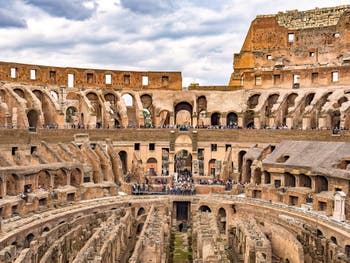
Colosseum Arena in Rome This belief in the use of the Colosseum as a place of martyrdom for early Christians was, on the other hand, an opportunity for the Colosseum itself.
While he was abandoned and threatened to collapse, the papacy decided to make it a place of worship to honour his martyrs and had all the necessary works done.
At that time, and Charles Dickens witnessed it, a large cross was placed in the centre of the arena and, by day and night, people would kiss this cross which... made it possible to obtain 100 days' plenary indulgence!
« There are several Crosses in Rome, too, the kissing of which confers indulgences for varying terms.
Colosseum Arena in Rome That in the centre of the Coliseum is worth a hundred days; and people may be seen kissing it from morning to night.
It is curious that some of these crosses seem to acquire an arbitrary popularity, this very one among them.
In another part of the Coliseum there is a cross upon a marble slab, with the inscription, "Who kisses this cross shall be entitled to Two hundred and forty days' indulgence."
But I saw no one person kiss it, though, day after day, I sat in the arena, and saw scores upon scores of peasants pass it on their way to kiss the other. »
Charles Dickens — Pictures from Italy (1877)
Death Sentenced to the Colosseum
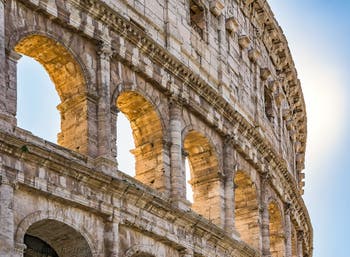
Colosseum Arena in Rome If there was not a single Christian executed in the Colosseum, the executions of persons sentenced to death in the arena are well documented. These capital executions could take several forms.
They could be grazed to wild animals, or they were forced to fight among themselves until death. For those convicted, death was therefore atrocious and certain.
However, some managed to avoid death.
Indeed, those who fought with courage and skill in the arena succeeded, when they were able to raise the enthusiasm of the spectators, to have their lives saved and even to be pardoned.
Plundering and Destruction of the Colosseum
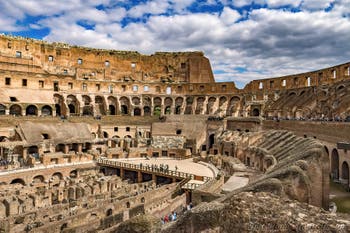
Colosseum Arena in Rome Already more or less shaken by some earthquakes, abandoned, returned to nature, plants and trees having taken their place in the middle of the stones, the Colosseum, in the 15th and 16th centuries, was also used as a quarry for building materials, bricks and marbles.
The architects responsible for the construction of the palaces of Farnese, Venezia, Cancelleria, and Barberini were widely used in marble by plundering the Colosseum.
What saved the Colosseum from ruin was the erroneous belief that Christian martyrs had been executed there.
As the Colosseum became a place of memory and worship for these martyrs, the Roman Church then spent considerable sums involving hundreds of workers, clearing the premises of any invasion of plants and trees and reconstructing and fortifying some of the destroyed parts.
Long live the fake news, they saved one of the most beautiful monuments in Rome!
Games Martyrs Story Architecture | Games Gladiators | Martyrs
Colosseum Games Martyrs | Location | Opening Hours Tickets | Authorisations | Roman Forum
Back to Top of Page


